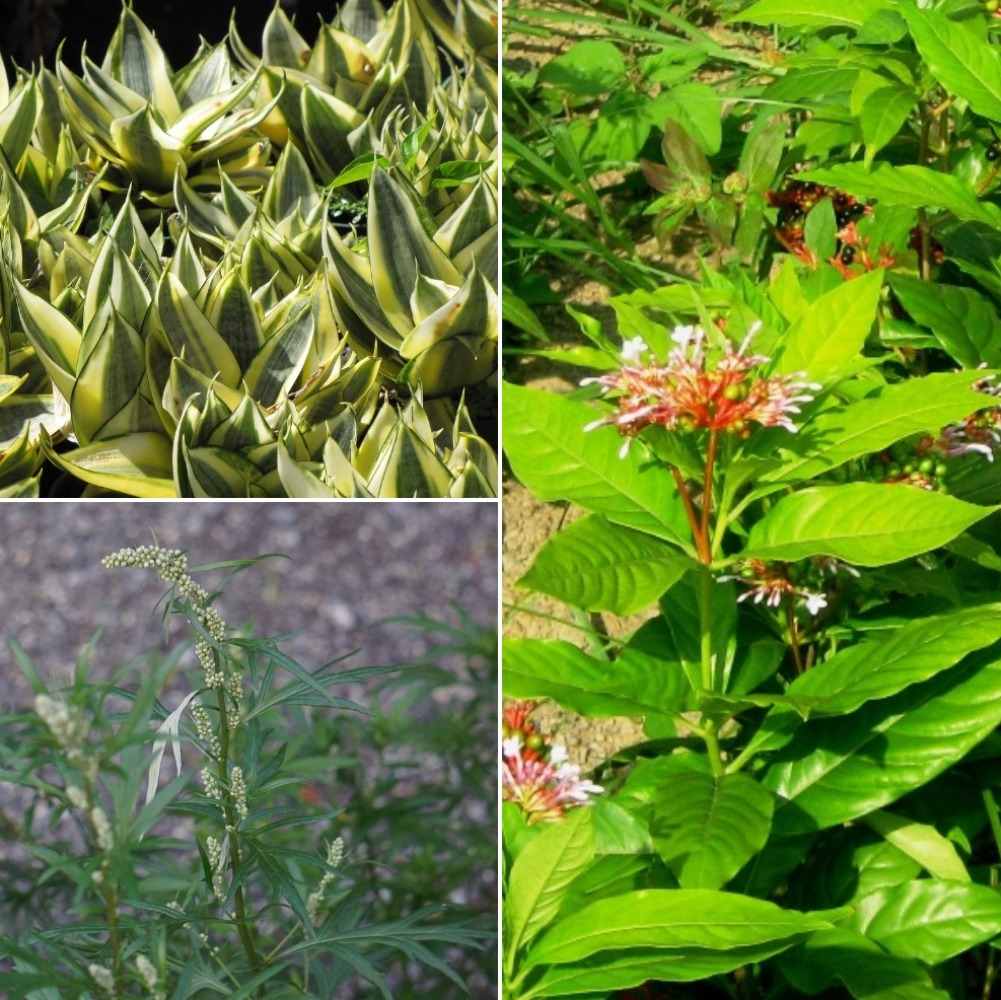Introduction: Hello gardeners keeping the snakes away from your home is very important and we are here to help you with that. Today we will discuss plants that repel snakes away. Certain plants like marigold, wormwood, West Indian lemongrass, Pink agapanthus, Indian Snakeroot, Sarpgandha, and garlic are natural repellent against snakes.
A step by step guide to plants that repel snakes away
These plants have bitter tastes and strong smells that cause discomfort to snakes when they slither over them. These plants can be planted around homes and gardens to chase away serpents that cannot tolerate their strong odors.
Snakes do not like strong smells, so employing a mixture of plants will give above ground and below ground coverage.
Some of the plants that repel snakes are given below;
Marigolds
Marigolds are undoubtedly pretty flowers with their vivid yellow color, but these release an odor that isn’t desirable to all. Insects and nematodes aren’t mainly fond of the marigold’s scent. Also, farmers and homeowners alike use this against possible snake appearances.
There isn’t much scientific evidence backing up the efficacy of marigolds against snakes, but it’s a popular selection due to its availability and affordability. These plants can be bought at garden stores for transplanting, or you can begin from seeds and sow them on your own. Marigold plants require full sunlight and well-draining soil. Keep the soil moist through adequate irrigation.
Marigolds are normally used to deter pests and the reason is in the roots of the plant. The plant has traditionally been implemented to deter gophers and moles. The roots produce deep and aggressively, which give off a strong odor that repels many garden pests and critters. What’s more, the bright flowers look good on property. Marigolds can give a hiding spot for mice and other snake prey; however, the root’s strong odor keeps pests from settling in.
Mother-in-Law’s Tongue (Variegated snake plant)
Mother-in-Law’s Tongue is one of the best plants that repel snakes because of its sharp leaves but also the plant rejuvenates the oxygen at a higher-than-normal rate. Mother in laws tongue is also called as the snake plant or Viper’s Bowstring Hemp. The plant is so named because of its sharp leaves and snakes don’t like its appearance.
Unlike some smelly plants, snakes find the sight of Mother-in-Laws Tongue frightening. It is a great-looking plant to have around the garden as a barrier against snakes and it is low maintenance. The snake plant needs water only three times per week and this perennial plant will last for many years. If propagating from a single host plant, be sure to let the roots establish themselves first for at least 3 months after planting. This plant is used as a snake repellent for warm outdoor climates and indoors in cool climates.
You should not miss the Small Space Vegetable Gardening in India.

This plant is most distinguished by its sharp leaves. This sharp appearance of the foliage is enough to dissuade snakes from approaching. The snake plant can be grown through cuttings placed in potting soil.
This plant thrives in bright light and it can be grown during any season. Moreover, this can be grown indoors to help develop air circulation. This plant has a decent tolerance to drought but it must not be exposed to strong cold winds and sudden frosts.
Andrographis Paniculata
Andrographis paniculata is commonly known as green chireta. It is an annual herbaceous plant in the family Acanthaceae. This herb is normally found in Asian countries such as India, Malaysia, and Sri Lanka. Similar to the marigold plant, the Andrographis paniculata plant is believed to be a good snake repellent. People could also rub the Andrographis paniculata plant on the scales of a snake. This causes the snake’s skin to become swollen. Also, this plant is used as a traditional medicine for treating sinus infections and the common cold.
It can be simply raised through seed and vegetative methods. But in commercial cultivation, propagation through seed is very easy and economical. Water gently and maintain the soil evenly moist until the seedlings have germinated in approximately five to seven days.
Indian Snakeroot
Indian snakeroot also called devil pepper, sarpagandha or Rauvolfia serpentina. The Indian snakeroot plant is used as a traditional medicine in India and other countries in East Asia. Both the foliage and the roots are mainly used to repel snakes.
The Indian snakeroot contains reserpine, which is recognized to cause sleepiness and to slow down one’s heart rate. Also, the Rauvolfia serpentina plant is used to treat snake bites.
Indian snakeroot plant has been used in traditional Ayurvedic medicine in India, mainly for high blood pressure and mental illness. And, one of the chemicals in Indian snakeroot is the same as a prescription drug called reserpine. The Indian snakeroot is a traditional Indian herb. Indian snakeroot plant is an important medicinal plant in indigenous systems of medicines. This snakeroot plant is known for its ability to repel away snakes.
Pink agapanthus
The Pink Agapanthus plant is of the onion family. Pink agapanthus plant is a fast-growing, clumping perennial with narrow, garlic-scented leaves and large umbels of fragrant lilac flowers in summer and early fall. This plant grows to 2 feet tall. Adaptable to most any soil that is well-drained, loamy, and moderately fertile. In case you choose flowers over plants, pink agapanthus makes a perfect choice to have in the garden. It is a great option for keeping snakes away. The scent of both the flowers and foliage simply irritate the snakes and scare them away. This beautiful flower can repel fleas and mosquitoes as well while providing many more benefits. You can use it to treat headaches and sinus infections, and it looks super great in the garden. Pink agapanthus plant has great tolerance to significant heat and drought, so it is an ideal plant for summer.
Moreover, the pink agapanthus plant is used to treat headaches and sinus infections. And you can even consume the foliage if you want. Aesthetically, the pink agapanthus plant looks great in anyone’s garden.
Onion and Garlic
Onions and garlic plants are very useful garden plants for repelling snakes. Both plants give off a smell that snakes not only dislike, but it confuses them. Onions and garlic plants are thought to be the best plants that repel snakes. The Onion plant gives off an oily residue when a snake slithers over a clove. This oil acts very much like an onion does when we slice it and the aroma is disorienting like a pepper spray.
You may also like the Profitable Hydroponic Crops.

West Indian Lemongrass (Cymbopogon citratus)
Snakes don’t like the citrus smell from the plant leaves. The plant leaves or the tips can turn brown in extreme heat in summer. It requires little care. The entire stalk (bulb and grass) has a light lemon flavor and it is used in soups, curries or teas. West Indian Lemon Grass is much chosen over the seed-grown East Indian variety since it’s larger and more flavorful. Lemongrass mainly contains citrol and is made into teas to aid digestion. This tropical perennial plant performs well as a container-grown herb.
West Indian Lemongrass produces a citrus smell that deters snakes. Citronella is a by-product of lemongrass, which mosquitoes detest. This is one of the best plants that repel snakes, mosquitoes, and even ticks from the garden. Lemongrass is drought-resistant and very easy to maintain. Use the lemongrass plant to form a secure barrier from snakes and repel mosquitoes and ticks at the same time.
Kaffir-Lime
Snakes don’t like the smell of kaffir-lime, and they generally stay away from the places with kaffir-lime trees. People usually put leaves, fruit, and the peels of kaffir-lime in various places inside and outside the house. The strong smell of kaffir-lime repels the snakes as well as some insects and pests away. No matter if it is the lime or the whole plant, snakes are afraid of all of them.
The Kaffir lime tree (Citrus hystrix) is also known as makrut lime is commonly grown for use in Asian cuisine. The glossy, dark green leaves of the Kaffir lime are quite distinctive. Kaffir lime plant leaves look like two leaves joined together, as one appears to grow from the tip of the other. Kaffir lime leaves are most often used as a necessary ingredient for flavoring many Asian dishes such as soups, curries, and fish. Kaffir lime plants prefer full sun in moist, well-drained soil. If grown plants indoors, keep near a sunny window. The Kaffir lime plant appreciates water and somewhat humid conditions during the growing season.
Tulbaghia Violacea
For best results grow Tulbaghia violacea plant in fertile, moist but well-drained soil in full sun. Tulbaghia violacea plant is a clump-forming herbaceous perennial that will spread slowly by its rhizomes but will not become aggressive. It is easily grown in moderately fertile, light, medium moisture, well-drained soils in full sun.
This popular garden plant is particularly resilient (it tolerates prolonged droughts) and can be used in different ways. These plants repel mosquitoes, fleas, and snakes. Its flowers and leaves can be used in salads, as headache remedies, or as a natural cough remedy.
Cactus
The indoor cactus plant tends to need less light and is smaller in size, making them the perfect houseplant. A cactus plant can survive without water for many, many months; but the rot is an instant killer. Cactus in pots requires more care in watering than in the ground. It is not just snakes; even humans don’t want to go anywhere near sparky things like cactus plants. Snakes are afraid of spikes and thorns the most and they always keep away from areas which such cactus plants. If you don’t like snakes around, simply plants spiky plants in the garden and yard to keep them away.
Mugwort
It is also known as Artemisia vulgaris. The mugwort has long been used as a traditional medicine in China, Korea, and Japan. This plant has essential oils that have insecticidal characteristics. As for its physical features, the mugwort plant has stems that could easily reach a height of three feet or more. Snakes tend to veer away from mugworts. While this is a good thing, you should be prepared for how fast mugworts can spread around your garden. They won’t speedily wither even if they aren’t well-maintained.
Mugwort or Artemisia vulgaris prefers a sunny, moist but well-drained soil. It does not like wet feet and dry soils produce good results. A shaded ‘woodland’ position is suitable as well. It can tolerate many soil conditions, including alkaline soil, with a pH level of 4.8 to 8.2.
Mugwort though considered by some to be an invasive weed is an excellent natural snake repellent for your yard. This plant grows quickly and widely, though it often overpowers other plants.
That’s all folks about plants that repel snakes naturally away from your home garden. You may be interested in Vegetable Weed Control Methods. Keep gardening.!